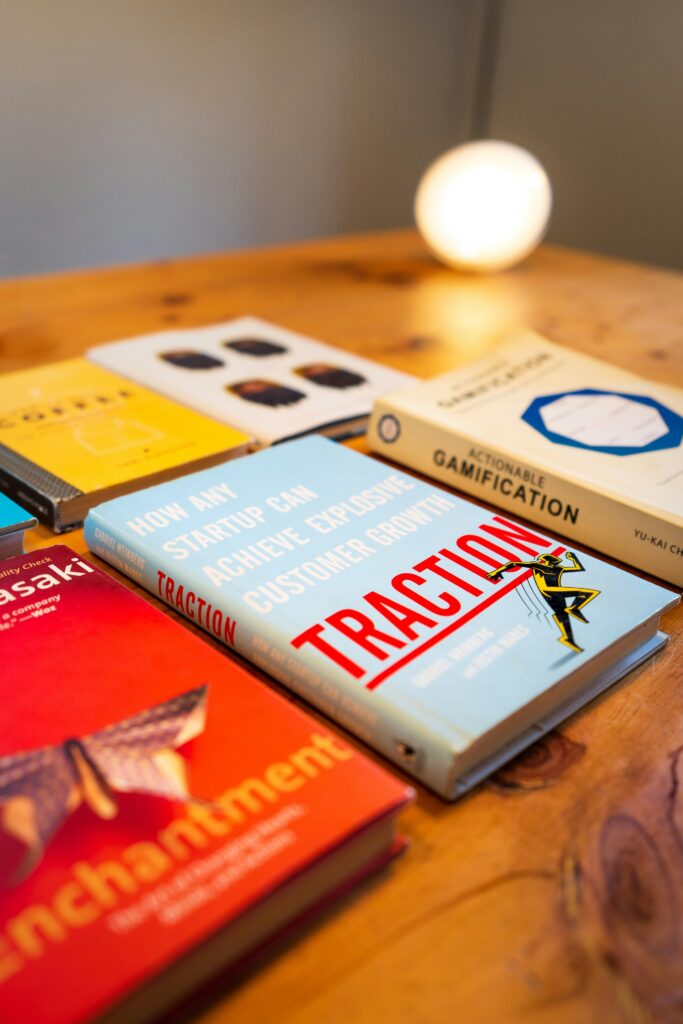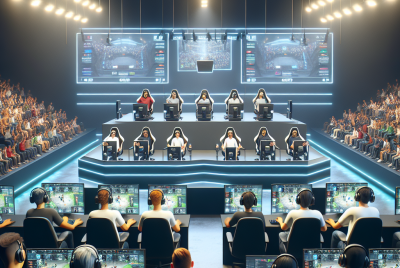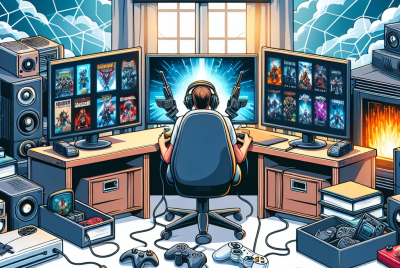Creating Serious Games for Training Purposes
Creating serious games for training purposes can be an exciting and impactful venture that blends elements of entertainment with educational objectives. By using engaging storylines, interactive gameplay, and real-life scenarios, we can develop training tools that not only educate but also motivate learners. Our journey into the world of serious game development will explore the critical steps, from understanding the learning goals and audience needs to designing mechanics that reinforce the training content. Together, we will delve into the creative and technical processes that make these games effective educational resources, ensuring that our training solutions are both purposeful and enjoyable. How do you create serious games for training purposes? This is a question that many learning and development professionals have been asking as they try to make training engaging and effective for their teams. As technology continues to evolve, so does the landscape of training methodologies. One exciting evolution is the use of serious games, also known as game-based learning, to enhance training experiences.
In this article, we will explore the intricacies of creating serious games for training purposes, ensuring we present detailed, actionable advice that we can all put to use. Let’s dive into this fascinating world!

Understanding Serious Games
Serious games are more than just entertainment. They combine the engaging elements of gaming with practical and educational purposes. This concept merges fun and learning, turning training sessions into immersive experiences.
What Are Serious Games?
Serious games are specially designed and used for purposes beyond mere entertainment. They can be aimed at education, training, policy and planning, research, and health or therapeutic goals. Unlike traditional games, the primary objective isn’t entertainment but the acquisition of skills, knowledge, and experience.
Why Use Serious Games for Training?
Serious games offer numerous benefits for training purposes. These include:
- Higher Engagement: Games are inherently engaging and can capture the trainee’s attention more effectively than traditional training methods.
- Interactive Learning: They allow learners to actively participate, making the training process more dynamic and interactive.
- Immediate Feedback: Players receive instant feedback, helping them understand their mistakes and correct them on the spot.
- Safe Environment: Trainees can experiment with different approaches in a risk-free environment.
Popular Examples of Serious Games
To provide some perspective, here are a few widely recognized examples of serious games:
| Game Name | Purpose | Description |
|---|---|---|
| Duolingo | Language Learning | Engages users with simple, motivational language exercises. |
| Foldit | Scientific Research | Players fold proteins to help scientists understand disease-related proteins better. |
| CodeCombat | Learning Programming | Teaches coding concepts in a fun, game-like environment. |
| America’s Army | Military Training | A military recruitment tool that also serves as a training platform for certain scenarios. |
Key Elements for Creating Serious Games
Creating serious games is a multifaceted task requiring a perfect blend of instructional design, game mechanics, and effective storytelling. Let’s delve into the essential components you need to consider.
Setting Clear Learning Objectives
At the outset of any serious game development project, we need to establish clear learning objectives. These objectives serve as the guiding light for all our design decisions.
- Specific: Make sure the objectives are precise and well defined.
- Measurable: We should be able to quantify the learning outcomes.
- Achievable: The objectives must be realistic and attainable.
- Relevant: Align the objectives with the desired skills and knowledge.
- Time-bound: Set a clear timeframe for the achievement of these objectives.
Designing an Engaging Storyline
A compelling storyline forms the backbone of any successful serious game. Stories make the content relatable and memorable.
- Contextual Relevance: Ensure that the storyline is relevant to the learning objectives.
- Character Development: Create characters that users can connect with.
- Conflict and Resolution: Introduce challenges and conflicts that players need to overcome, leading to learning outcomes.
Incorporating Game Mechanics
Game mechanics are essentially the rules and systems that define the gameplay. These mechanics help to incentivize and motivate players.
- Rewards and Recognition: Implement a system of rewards such as points, badges, and leaderboards.
- Challenges and Levels: Introduce varying levels of difficulty and new challenges to maintain interest.
- Feedback Mechanism: Provide immediate feedback to help players learn from their actions.
Ensuring Usability and Accessibility
Usability and accessibility are critical factors that can make or break a serious game. We must ensure the game is easy to use and accessible to all trainees.
- User Interface (UI): Make it intuitive, visually appealing, and easy to navigate.
- Accessibility: Ensure the game accommodates different abilities and provides features like text-to-speech, subtitles, and alternative input methods.
Step-by-Step Process to Develop a Serious Game
Developing a serious game involves several stages, from conceptualization to deployment. Let’s break down this process into manageable steps.
Step 1: Needs Analysis
The first step in development is conducting a needs analysis. Determine what skills or knowledge gaps exist and how a serious game can address these needs.
- Stakeholder Interviews: Collect input from those who will benefit from the training.
- Surveys and Questionnaires: Utilize these tools to identify training needs.
Step 2: Define Learning Outcomes
Create a list of learning goals based on the needs analysis. Clearly outline what the players are expected to learn or achieve by the end of the game.
Step 3: Conceptualization
This phase involves brainstorming and sketching out the game’s basic concept.
- Game Theme: Choose a theme that aligns with the learning objectives.
- Mechanics: Decide on the game mechanics that will drive the gameplay.
- Storyline: Draft a storyline that is engaging and relevant to the learning objectives.
Step 4: Prototyping
Create a prototype of the game to visualize the concept and get initial feedback.
- Wireframes: Sketch basic layouts for the game.
- Mockups: Develop mockups showcasing key game elements and intended interactions.
Step 5: Development
This is the phase where the actual game development takes place.
- Programming: Develop the game using the chosen programming language and tools.
- Design: Create the visual and audio elements of the game.
- Integration: Integrate the storyline, mechanics, and other components.
Step 6: Testing
Testing is crucial to identify and fix bugs and ensure the game meets the learning objectives.
- Alpha Testing: Conduct internal testing by the development team.
- Beta Testing: Pilot the game with a small group of end-users and gather feedback.
Step 7: Launch
Once the game has been tested and refined, it’s ready to be launched.
- Deployment: Deploy the game across the intended platforms.
- Training: Provide instructions and resources to help users get started.
Step 8: Evaluation and Feedback
After the launch, continuously evaluate the game’s effectiveness and gather feedback for future improvements.
- Surveys: Conduct surveys to gain insights from players.
- Performance Data: Use analytics to assess how well players are achieving the learning outcomes.
Practical Tips and Best Practices
Collaborate with Subject Matter Experts
To create a game that effectively meets training needs, collaborate with subject matter experts (SMEs) who can provide valuable insights into the content and ensure the game is educationally sound.
Keep It Simple
Complex games can sometimes be overwhelming and counterproductive. Aim for simplicity in design and gameplay to ensure that the focus remains on learning.
Balance Fun and Learning
While it’s important for the game to be enjoyable, never lose sight of the primary educational goals. Striking the right balance between fun and learning is key.
Regular Updates
To keep the game relevant and engaging, regularly update it with new content, levels, or mechanics based on user feedback and evolving training needs.
Measure Impact
Use metrics to measure the game’s impact on training effectiveness. This could include performance scores, completion rates, and user feedback.

Tools and Technologies for Developing Serious Games
Numerous tools and technologies can aid us in the development of serious games. Here are some popular ones:
| Tool/Technology | Description |
|---|---|
| Unity | A powerful game development platform that offers flexibility and rich features. |
| Unreal Engine | Known for its high-quality graphics and robust development environment. |
| Articulate 360 | Useful for creating interactive courses and gamified learning experiences. |
| Twine | A tool for creating interactive stories, which is great for narrative-based serious games. |
| Gamemaker Studio | Allows for the creation of 2D games with an emphasis on simplicity and ease of use. |
Case Studies: Successful Serious Games
Foldit: A Game for Protein Folding
Objective: Use gaming to crowdsource scientific discovery. Approach: Players fold virtual proteins in the game, helping scientists discover new protein structures. Outcome: Successfully helped identify a real-world enzyme structure, contributing to AIDS research.
America’s Army: Military Training Simulation
Objective: Serve as a recruitment tool and training platform for the U.S. Army. Approach: Provides a realistic simulation environment where players can experience Army life and operations. Outcome: Effectively used for attracting new recruits and conducting various training simulations.

Future Trends in Serious Games
Virtual and Augmented Reality
Virtual Reality (VR) and Augmented Reality (AR) are poised to make serious games even more immersive and effective. These technologies offer immersive environments that can simulate real-world scenarios for training purposes.
AI and Machine Learning
Artificial Intelligence (AI) and machine learning can personalize the gaming experience by adapting to the player’s learning pace and style. This customization can make training more effective and engaging.
Gamification in Enterprise Management
More companies are integrating gamification into broader enterprise management solutions, from HR training to performance reviews, demonstrating its growing acceptance and effectiveness in the corporate world.
Mobile-Based Learning
The increasing use of smartphones has made mobile-based serious games more popular. On-the-go training modules can make learning more accessible and convenient.
Conclusion
Creating serious games for training purposes is an exciting and effective way to make learning more engaging and impactful. By understanding the key elements of serious games, following a structured development process, and using the right tools and technologies, we can design games that not only entertain but also educate.
As technology continues to evolve, the opportunities for serious games in training are endless. Let’s embrace this powerful tool to make learning an enjoyable and fruitful experience for all.




